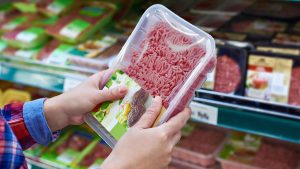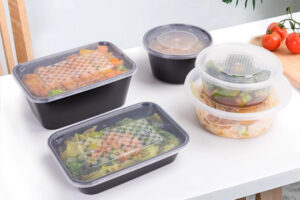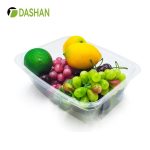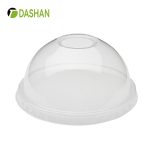Quick Summary
Explore the versatility and sustainability of Polypropylene Food Containers, including PP Trays, Compartment Food Containers, Hinged Lid Containers, and Injection-Molded Containers. Learn about their applications, benefits, and how they meet modern food packaging needs.
Introduction: Meeting the Demands of Modern Food Storage
In today’s fast-paced world, consumers and businesses alike seek food storage solutions that are not only functional but also safe, sustainable, and cost-effective. Polypropylene (PP) food containers have emerged as a popular choice, offering a range of benefits that cater to diverse needs. But what makes PP containers stand out in the crowded market of food packaging?
Xiamen Dashan New Materials Co., Ltd. offers a wide range of polypropylene food packaging solutions to meet industry specific requirements. These packaging solutions play a vital role in ensuring meals are safe, fresh and convenient. DASHAN offers a comprehensive selection of products including PP Trays, PP Food Containers and PP Hinged Food Containers to meet a variety of food packaging needs.
PP Plastic Meat Tray: Fresh Meat, Fish, and Poultry Packaging Solutions
PP

Compartment Food Containers
These containers feature multiple sections, making them ideal for portioned meals, salads, and bento-style lunches. The thermoforming process ensures a secure seal, preserving food freshness and preventing cross-contamination.
Polypropylene Hinged Lid Containers
Combining the benefits of compartmentalization with a hinged lid, these containers offer convenience and ease of use. They are widely used in delis, takeout services, and meal prep businesses for their practicality and secure closure.
Polypropylene Food Containers with Lids

Injection-molded PP containers are known for their strength and rigidity. They are suitable for both hot and cold food items and are commonly used in supermarkets and food processing industries. The injection molding process allows for precise control over dimensions and wall thickness.
📈 Industry Trends and Expert Insights
The global plastic food container market is projected to grow from USD 207.35 billion in 2023 to USD 344.79 billion by 2032, at a CAGR of 5.9% during the forecast period. Fortune Business Insights This growth is driven by increasing demand for convenient, safe, and sustainable food packaging solutions.
Experts highlight the importance of adopting recyclable materials like PP to reduce environmental impact. Additionally, advancements in manufacturing technologies are enabling the production of more efficient and customizable food containers.
🔬 Scientific Data Supporting PP Food Containers
Studies have shown that PP containers exhibit low migration rates of chemicals into food, ensuring safety during storage and consumption. Furthermore, PP’s resistance to moisture and fats helps in preserving food quality and extending shelf life.
🛠️ Case Studies and Real-World Applications
Case Study 1: Meal Prep Service Enhancement
A meal prep company transitioned from traditional plastic containers to PP compartment containers. This change resulted in improved food presentation, reduced leaks during transport, and enhanced customer satisfaction.
Case Study 2: Supermarket Packaging Upgrade
A supermarket chain adopted PP hinged lid containers for their deli section. The new packaging improved product visibility, extended freshness, and aligned with sustainability goals, leading to increased sales and positive customer feedback.
❓ Frequently Asked Questions (FAQs)
1. Are PP food containers microwave-safe?
Yes, most PP containers are microwave-safe. However, it’s essential to check the manufacturer’s guidelines for specific usage instructions.
2. Can PP containers be recycled?
Yes, PP is widely recyclable. Ensure that the containers are clean and follow local recycling protocols.
3. Do PP containers leach chemicals into food?
Studies indicate that PP containers have low migration rates of chemicals, making them safe for food contact. PubMed
4. Are PP containers suitable for hot foods?
Yes, PP containers can withstand temperatures up to 160°F (71°C), making them suitable for hot foods.
5. How can I customize PP containers for my brand?
Many manufacturers offer customization options, including printing logos and selecting colors, to align with your brand identity.
✅ Conclusion: The Smart Choice for Food Packaging
Polypropylene food containers offer a blend of safety, functionality, and sustainability. Whether you’re in the food service industry, meal prep business, or retail sector, PP containers provide reliable solutions that meet modern packaging needs. Their versatility and recyclability make them a smart choice for businesses aiming to enhance product presentation while adhering to environmental standards.
References:
-
Fortune Business Insights. (2024). Plastic Containers Market Size, Share | Growth Report [2032]. Retrieved from https://www.fortunebusinessinsights.com/plastic-containers-market-102372
-
ScienceDirect. (2024). Closed-loop recycling of polypropylene: A case study on …. Retrieved from https://www.sciencedirect.com/science/article/pii/S0921344924001320
-
PubMed Central. (2023). Cooking food in microwavable plastic containers. Retrieved from https://pubmed.ncbi.nlm.nih.gov/36924723/
-
Packaging Strategies. (2011). Case study: MyFit Foods container overhaul. Retrieved from https://www.packagingstrategies.com/articles/84376-case-study-myfit-foods-container-overhaul
-
WRAP. (2019). Food grade recycled polypropylene (rPP) in packaging. Retrieved from https://www.wrap.ngo/resources/case-study/food-grade-recycled-polypropylene-rpp-packaging
-
ScienceDirect. (2024). Life cycle assessment of reusable plastic food packaging. Retrieved from https://www.sciencedirect.com/science/article/pii/S0959652624009776
-
Maximize Market Research. (2024). Plastic Food Container Market Size, Share, Industry Trends, Growth Drivers, Opportunities, Key Players Analysis, Regional Outlook and Forecast Report (2025–2032). Retrieved from https://www.maximizemarketresearch.com/market-report/global-plastic-food-container-market/67257/
-
ScienceDirect. (2024). Assessing the Release of Microplastics and Nanoplastics from …. Retrieved from https://pubs.acs.org/doi/10.1021/acs.est.3c01942
-
Packaging Digest. (2023). Food grade recycled polypropylene (rPP) in packaging. Retrieved from https://www.packagingdigest.com/sustainability/food-grade-recycled-polypropylene-is-poised-for-us-intro
-
ScienceDirect. (2024). Exposure to leachates of plastic food containers disturbs …. Retrieved from https://www.sciencedirect.com/science/article/pii/S0147651324015744






